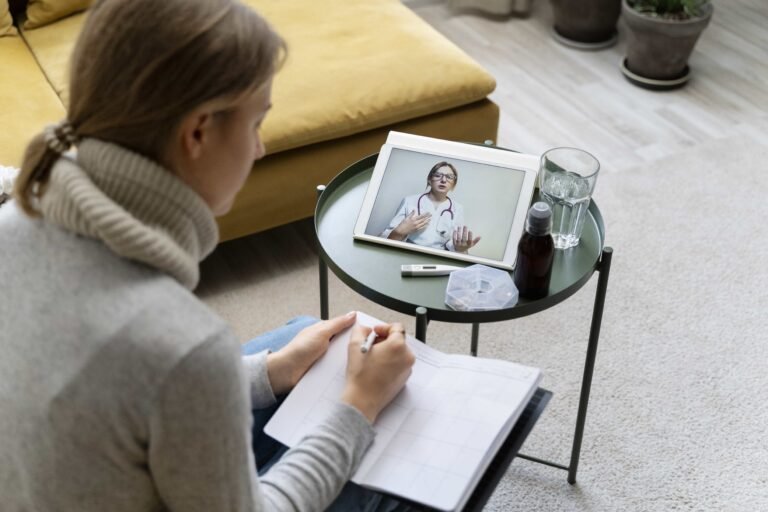✉️ contact@ayuschool.com
While telemedicine offers immense potential benefits, actually integrating it into clinical practice requires learning new skills, workflows and technologies. This module covers practical aspects of setting up a virtual care delivery system, conducting remote consultations, utilizing connected health tools, ensuring data security and blending telemedicine with traditional practice.
Setting Up a Telemedicine Practice
Key steps in establishing a telemedicine practice:
- Choose software platforms like Doxy, Practo considering features, integration with HMS, compliance factors.
- Select hardware like webcams, digital diagnostic kits, smart devices as per services offered and budget.
- Train doctors and staff on virtual consultation protocols and onboarding patients.
- Create detailed clinical workflows mapping patient journey across in-person, remote visits.
- Ensure reliable high-speed internet and IT infrastructure. Access to electronic health records.
- Develop information materials, consent forms for patients explaining telemedicine services.
- Apply for required license and liability coverage for delivering online care as per telehealth policy.
- Install cybersecurity systems to safeguard patient privacy according to HIPAA digital healthcare data norms.
- Design robust documentation, record management and billing systems suited for teleconsultations.
- Set quality assurance metrics and processes like patient satisfaction surveys, audits for continual improvement.
Choosing the right platforms, protocols and policies is vital for smooth implementation of telehealth capabilities.
Conducting a Virtual Consultation
Some best practices for doctor-patient video consultations:
- Confirm patient identity, contact information and consent at start.
- Brief orientation to the teleconsultation process and troubleshooting options if technical issues arise.
- Adjust webcam for ideal framing, lighting to see facial expressions and body language.
- Speak slowly and clearly. Summarize and repeat key points. Avoid medical jargon.
- Actively listen with empathy. Elicit full history and description of health issue and symptoms.
- Guide physical examination by asking patient or caregiver to demonstrate issues like range of motion.
- Share visuals like anatomy diagrams, lab results electronically for discussions.
- Provide clear post-consult instructions on medications, therapy and follow-up.
- Document telehealth visit completely with clinical findings, diagnosis, prescription and next steps.
Good virtual visit etiquette and engagement creates patient confidence in remote diagnosis and treatment.
Digital Diagnostics and Assessments
Various tools enable collecting clinical parameters and data during teleconsultations:
- Vital signs monitoring devices can capture and transmit readings of blood pressure, temperature, respiratory rate, oxygen saturation, ECG etc.
- Digital stethoscopes allow auscultation of heart and breath sounds which get relayed for diagnosis.
- Mobile health apps interface with external devices for self-measurement of vitals using automated algorithms.
- Digital imaging technologies transmit pictures of skin lesions, wounds etc. for analysis by provider.
- Questionnaires can screen for common conditions like depression, anxiety, ADHD using validated scales.
- Movement assessment tools video record patient performing standardized motions to evaluate range, coordination issues.
- Retinal imaging using special cameras can screen for common eye diseases like diabetic retinopathy, glaucoma.
- At-home test kits can collect and send samples for cholesterol, A1C, urine culture etc. enabling remote diagnosis.
When selected appropriately, these digital health platforms extend the physical examination and speed diagnosis through telemedicine.
Patient Privacy and Data Security
Protecting sensitive health information in telemedicine requires:
- Using only HIPAA or GDPR compliant telehealth software platforms which encrypt data and communications.
- Multifactor identity verification of patients before virtual visits.
- Using secure messaging for sharing test reports and images.
- Masking personal identifiers and maintaining anonymity when presenting patient histories for training purposes.
- Recording consent for storing or transmitting images and videos of patients.
- Using secure cloud services with access restrictions for storing patient data like EHRs, biometric information.
- Setting data use policies on who can access medical records and for what purpose.
- Training staff on protocols for collecting, storing and sharing patient health information.
- Reporting any potential privacy or security breaches as per mandatory organizational guidelines and legal requirements.
With careful implementation of cybersecurity controls, telemedicine can uphold the same confidentiality standards as traditional in-person practice.
Integrating Telemedicine with Traditional Practice
Blending telehealth tools into conventional practice settings:
- Maintain option for in-person visits, especially when physical examination is required. Offer remote follow-ups.
- Share tele consult summaries like diagnosis, prescription with patient’s in-person care team for continuity.
- Staff roles may evolve from patient intake to virtual visit coordination and guiding technology use.
- Waiting areas can have connected health stations for collecting patient vitals and data prior to visits.
- Telemedicine workstation can be set up in nursing stations to facilitate provider access and coordination.
- Expand the care team’s capabilities by including nutritionists, health coaches for virtual education and monitoring.
- Use patient portal to share digitized health records, lab results and accept telehealth appointments.
- Install user-friendly tablets, kiosks for patients to connect with care providers before and after in-clinic consultations.
- Offer hybrid visit options like tele screening followed by in-person physician appointment for comprehensive care.
With thoughtful protocols telemedicine can seamlessly integrate with and enhance conventional practice.
In summary, delivering high quality virtual care requires adopting new tools and workflows while focusing on the human elements of empathy, ethics and efficacious communication.




